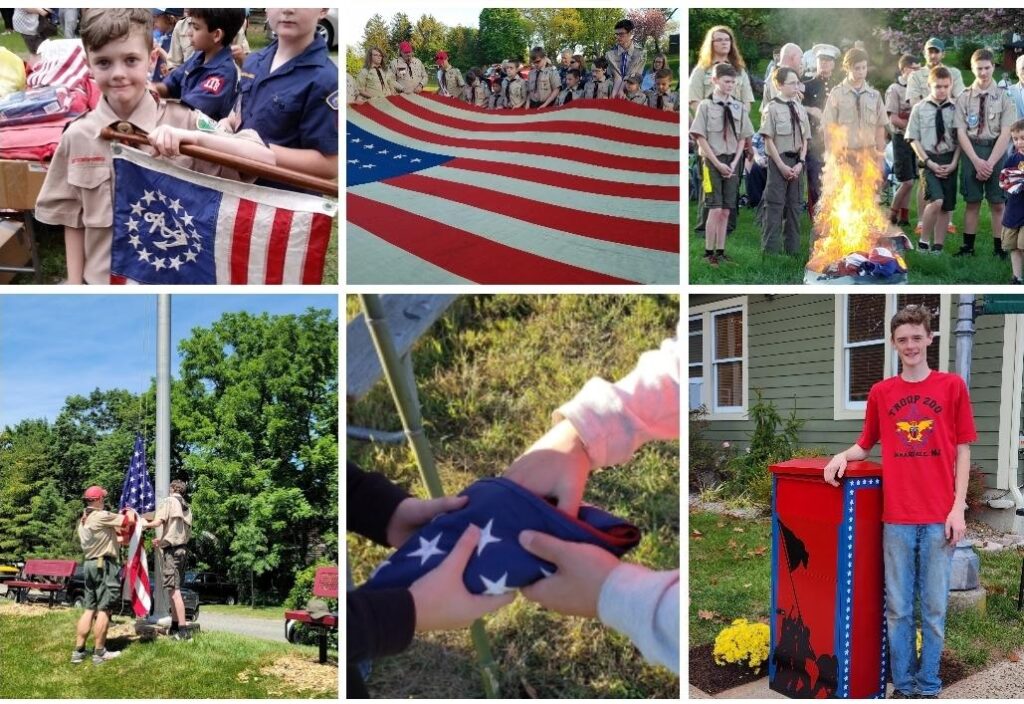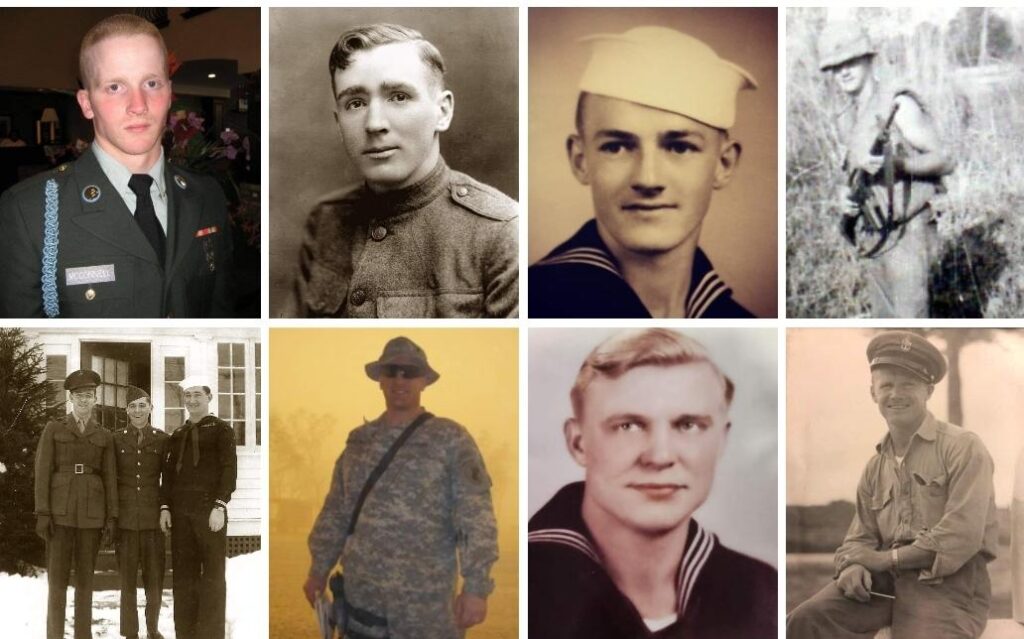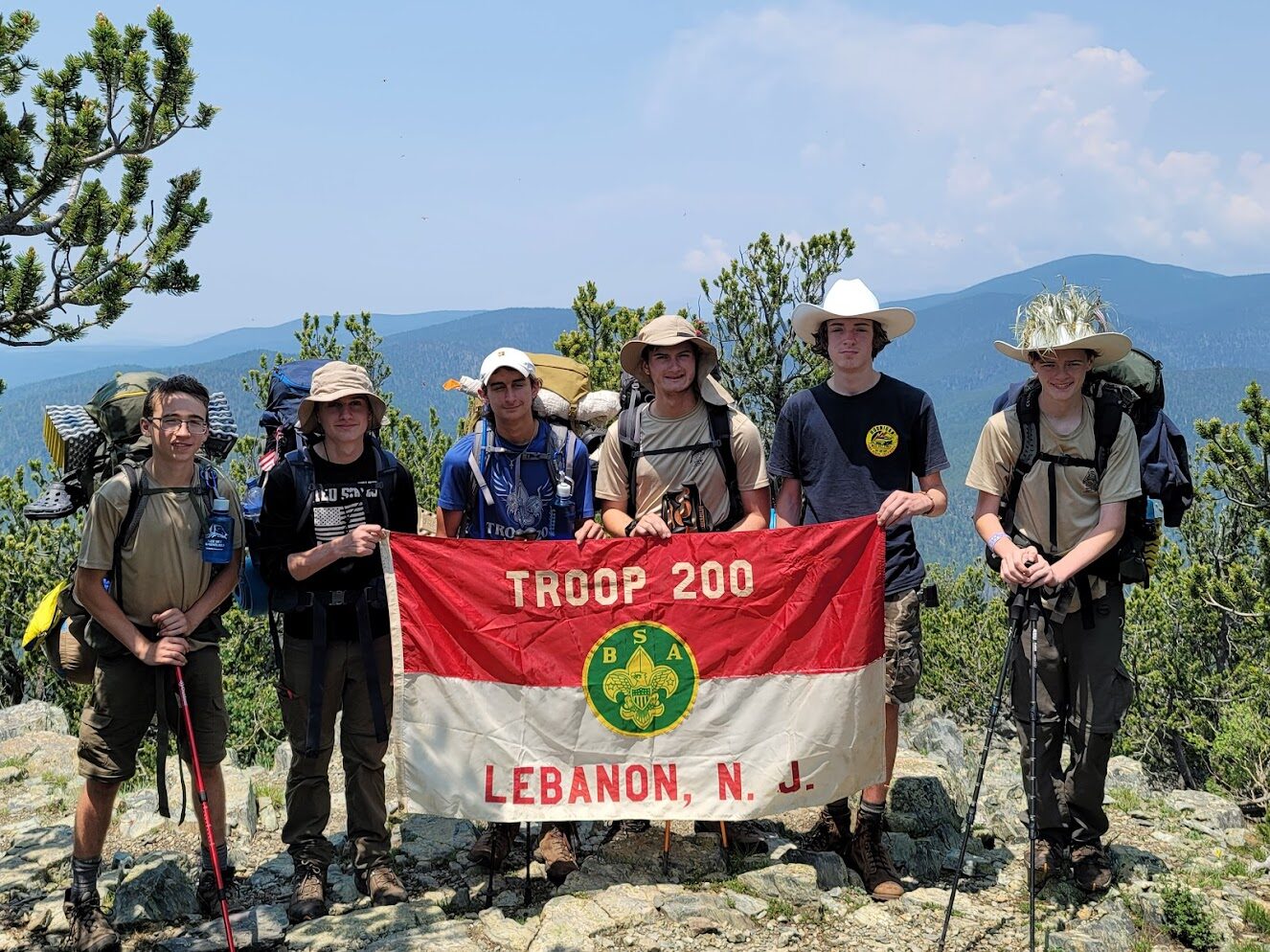This page was created as part of an Eagle Scout project led by Owen Maslanka, a member of BSA Troop 200 located in Lebanon, New Jersey. In addition to creating this page of flag etiquette and information he created a flag retirement bin located at 96 Main Street in Lebanon Borough where members of the community can dispose of their worn flags. The retirement bin includes a QR code directing people to this page to gain additional information on the bin, its design, the history of our flag and how to display and retire it.
The history of our flag dates back to the 1770’s. One June 14, 1777 the Continental Congress passed an act establishing an official flag for the new nation. The red and white stripes of the flag represent the original 13 colonies and the stars represent the states of the Union (which today are 50). The flag’s colors are symbolic, too. The red symbolizes hardiness and valor, the white symbolizes purity and innocence, and blue represents vigilance, perseverance and justice.

How should a flag be displayed?
Traditional guidelines call for displaying the flag in public only from sunrise to sunset. However, the flag may be displayed at all times if it’s illuminated during darkness. A flag should be raised briskly and lowered slowly. When a flag is displayed flat against a wall or window, or vertically, the “union” field of stars should be on the top left as you’re looking at it. When a flag is raised or lowered as part of a ceremony, and as it passes by in parade or review, everyone – except for those in uniform – should face the flag with their right hand over their heart. The U.S. flag should never be dipped toward a person or object and it should never touch the ground.
What happens if a flag touches the ground?
You always want to respect the flag, but accidents happen. One common misconception is that a flag that touches the ground must be retired, that is not true. You just need to carefully pick up the flag and carry on as usual.
When should we retire a flag?
When a flag is worn or soiled and in a condition that it should no longer be on display, it should be retired in a dignified and respectful manner. You should never throw a flag out in the trash (that would be disrespectful). According to the Flag Code, “when [a flag] is in such a condition that it is no longer a fitting emblem for display, [it] should be destroyed in a dignified way…”.
What is a flag retirement ceremony?
Flag retirement is a solemn, dignified event and it can involve shredding, burning or burying a worn or tattered flag. Locally, Lebanon Borough’s Boy Scout Troop 200 retires flags. In 2022, a Scout from Troop 200 installed a flag retirement box located at 96 Main Street in Lebanon, New Jersey as part of his Eagle Scout project. If you live nearby, you can drop your worn and tattered flag off at any time. Scouts from the troop monitor the bin, retrieve and properly retire the flags. Troop 200 usually retires flags in the Spring and a second time in the Fall. A number of veteran and civic groups also retire flags throughout the year, but any person or group can retire a flag as long as it is done in a respectful manner.
Why do we fold a flag in a triangle?
The flag gets folded into a triangle because it is actually meant to resemble a tri-cornered hat, like the ones worn by George Washington and other soldiers who served in the Continental Army during the Revolutionary War. Some people interpret the tri-fold to represent the three branches of government, the Executive, Legislative and Judicial under the US Constitution.
Watch this video to learn how to properly fold a flag into a triangle or view these directions from the Veterans Administration.
What is the proper way to retire a worn and tattered flag?
An American flag should always be treated with respect, even if it is worn, faded or tattered. There are three ways to dispose of – or retire – an American flag; but first it should be lowered with care.
- Burn. This is usually suggested for flags that are made of natural fibers like wool or cotton. A fire should be hot enough to engulf the flag once it is placed in the fire. If you’re having a formal flag retirement ceremony the flag should be saluted and the Pledge of Allegiance should be recited. After the flag(s) are completely consumed the fire should be safely extinguished and the ashes buried.
- Bury. To bury a flag you should first fold it in a triangle and then place it in a wooden box. A small, respectful ceremony should be held as the flag is buried in the ground.
- Shred. Cutting a flag up is acceptable as long as it is done in a reverent way. You should have a sharp pair of scissors and cut each of the 13 stripes carefully from each other, leaving the blue field and stars intact. Be careful to be reverent and respectful, do not let the pieces touch the ground. Once complete you can either burn or bury the pieces of the flag as mentioned above.
Safety first. Remember to have a fire extinguisher nearby and to always follow local/state fire codes and ordinances.
Can you recycle or repurpose a flag?
Patriotism is great but you should never use a flag for any purpose other than what it is intended for. You shouldn’t turn it into a blanket, clothing, pillow, etc.
Are some flags better than others?
Some flags are made out of less eco-friendly synthetic materials or treated with chemicals. When burning these types of flags there will be fumes so it may be better to either shred or bury those flags. Natural fabrics like wool or cotton would be a better alternative but they do not always hold their color as long as the synthetic types.
Can you tell me about the design of the flag retirement bin?
Using red, white and blue, the flag retirement bin has a patriotic design including: stars, stripes and images honoring the U.S. military and our history. There are 202 stars on the box one each for Troop 200 scouts Frederick Y. Holjes and Robert P. Sheppard and the remaining 200 were placed in honor or memory of a U.S. servicemen and women who served our country in war or conflict. Both Fred and Shep grew up in Lebanon Borough and were scouts with Troop 200. Fred was the first Cub Scout to cross over to the Troop in 1955 and Shep was Troop 200’s very first Eagle Scout. Both young men were killed in action during the Vietnam War. Troop 200 continues to remember and honor both men by displaying their names on the Troop 200 neckerchief. For more information on Holjes, Sheppard and the Troop 200 neckerchief click here.

The military members and veterans represented via the stars on Lebanon Borough’s flag retirement bin include:
French & Indian War
Abraham Brokaw, Captain Dumont’s 6th Company, NY Militia
Issac Brokaw, Private Soldier
The American Revolution
Caleb Brokaw, Captain Dumont Broom’s Co., 2nd Regiment, Somerset County Militia
Isaac Brokaw
Capt. John Isacc Stryker, Commander of the NJ Light Horse Brigade, NJ Militia
Peter Stryker, Troop of the Light Brigade, Frelinghuysen’s Battalion, NJ Militia
Cornelius V. Van Campen, Corporal – Continental Troops
War of 1812
Abraham C. Brokaw
Civil War
Ebenezer Dalley, 30th Regiment of the NJ Volunteers
Caleb Brokaw, 120th Regiment of the Ohio Infantry
Spanish American War
Rutherford B.H. Dalley, Company H 3rd NJ Regiment
World War I
Frank Cunningham, Army
Leonard Cunningham, Army
Leroy V. Dalley, Army
David Johnson, Army
Pfc Patrick D. McGovern, Army, 11th Field Artillery, Bat E
World War II
WAC Marion Robertson Boggs, European Theater
Harry W. Bunk, Army
LT John T Burgess, Navy, Mediterranean
William Cunningham, Army, Italy
Robert Dawson, Navy, South Pacific
Cpl George DeRose, Army Air Corps
Captain John Ehlers, Air Force
John Hansen, Navy, Pearl Harbor
Frederick A. Johnson, Navy, South Pacific
Timothy Joseph Johnson, Marines, China-Burma-India theater
Joseph Keenan, Marines, South Pacific
John Maslanka, Navy, Seabees, South Pacific
SGT 1 Class Harry Milne, 175th Engineers, North Africa
Leonard H. Piechocki, Army
Delwyn Eugene Robertson, Marines
Alexander Sieracki, Army, Pearl Harbor
Seaman 1st Class Arthur L. Wells, US Coast Guard, USS Belfast (PF-35) 7th Pacific Fleet
Korea
Lester Dalley, Army
Delwyn Eugene Robertson, Marines
Vietnam
Edward Dalley, SP4 Army
**Larry MOAT Friend, Navy
*Frederick Holjes, 2nd LT, Army
Frederick W. Johnson, Army
Delwyn Eugene Robertson, Marines
*Robert P. Sheppard, Warrant Officer, Army
PH2 Craig Stephens, Navy
SGT Fred J. Zyck, Army
Desert Shield & Desert Storm
Global War on Terror
Cpl. Luigi Marciante, Jr., Army, Iraq
SGT Derek McConnell, Army, Afghanistan
LTC Richard McGowan, Army, Iraq & Afghanistan
*= Troop 200 Scout
**= Troop 200 Scouter/Leader
Resources: https://www.federalflags.com, https://www.grandnewflag.com, https://colonialbrewer.com, https://www.va.gov, https://veterans.nv.gov
